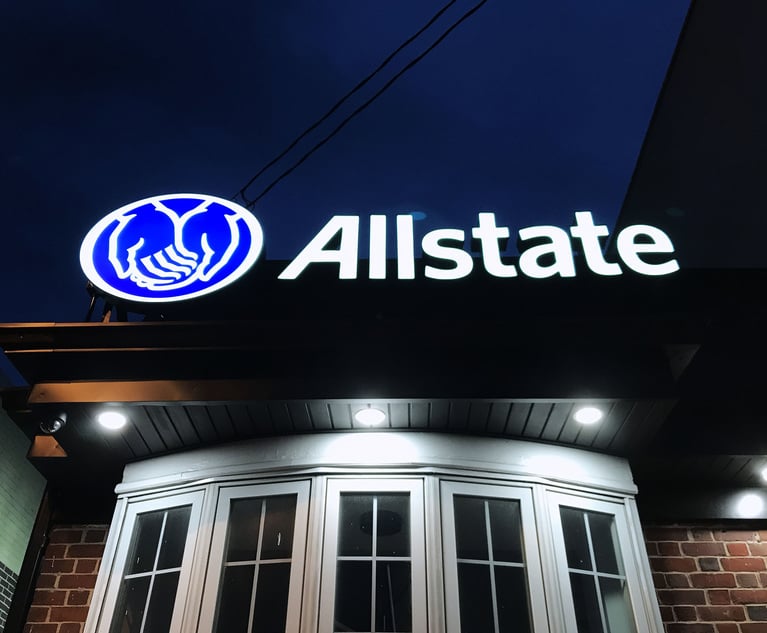Could 'SAS Institute' Signal the End of Partial Institutions in IPR Proceedings?
While Oil States Energy Services v. Greene's Energy Group, challenging the constitutionality of “inter partes review” (IPR) proceedings, has received the lion's share of coverage, the U.S. Supreme Court's other IPR case—SAS Institute v. Matal—warrants attention.
February 13, 2018 at 04:05 PM
5 minute read

While Oil States Energy Services v. Greene's Energy Group, challenging the constitutionality of “inter partes review” (IPR) proceedings, has received the lion's share of coverage, the U.S. Supreme Court's other IPR case—SAS Institute v. Matal—warrants attention. The case addresses whether 35 U.S.C. Section 318(a) requires the Patent Trial and Appeal Board (PTAB) to issue a final written decision for every claim challenged in an IPR petition or only those under review. This is, in essence, a challenge to the PTAB's established practice of partial reviews and calls into question the precept of administrative deference in Chevron U.S.A. v. Natural Resources Defense Council. Although perhaps understated, the court's grant of certiorari in SAS Institute casts doubt on the likelihood of wholesale invalidation of IPRs. Assuming they remain viable, SAS Institute may impact how patent owners and challengers proceed vis-à-vis IPRs.
IPR Final Written Decisions
Congress created IPR as a mechanism for agency-adjudication of patentability on certain grounds. 35 U.S.C. Section 314 requires the PTAB to make a “threshold” determination whether there is a “reasonable likelihood” the petitioner “would prevail with respect to at least one of the claims challenged in the petition,” and, if so, conduct an adjudication of patentability. This determination is not appealable. After the proceeding, the PTAB must issue a “final written decision with respect to the patentability of any patent claim challenged by the petitioner.” Once the PTAB enters a final decision, the petitioner is estopped from asserting invalidity on grounds it raised or reasonably could have raised during the IPR.
'SAS Institute': Partial Institution Challenged
In SAS Institute, the Supreme Court will decide the scope of section 318(a)'s final written decision requirement. SAS Institute (SAS) challenges the PTAB's practice of issuing final written decisions only on claims for which it instituted IPR—a practice that stems from implementing regulations permitting the PTAB “to proceed on all or some of the challenged claims.” The Federal Circuit, in the proceedings below, and Synopsys v. Mentor Graphics endorsed the PTAB's position that Section 318(a) requires only final written decisions for claims under review in an IPR.
SAS's challenge stems from what it contends is the plain language of section 318(a) requiring a “final written decision with respect to the patentability of any patent claim challenged by the petitioner” (emphasis added). SAS argues the statute “means what it says”—the PTAB must issue final written decisions on all claims “challenged by the petitioner” regardless of the scope of instituted review. In cases of partial adjudication, this boils down to the final written decision including the PTAB's decision that certain claims challenged in the petition did not meet the standard for review. SAS contends that this is proper because the section 314 threshold determination is a patentability determination. As Justice Sonia Sotomayor pointedly suggested, SAS's argument would effectively make the PTAB's institution decision appealable, circumventing Cuozzo Speed Technologies v. Lee, finding the PTAB's institution decision unreviewable by federal courts.
Respondents, USPTO and ComplementSoft, LLC, contend that section 318(a) must be read in context and focus on phrasing differences between section 314's “would prevail with respect to at least one of the claims challenged in the petition” and Section 318(a)'s “claim[s] challenged by the petitioner” to argue that final written decisions are limited to claims under review. Respondents acknowledge the crux of the debate is the propriety of partial adjudications: “Our point is that the statute Congress enacted is consistent with partial institution. But to the extent there's a question about that, Congress left those questions to the agency.”
Both sides argue their statutory constructions further Congress's objectives, but they differ on what those objectives are: Drawing on Judge Newman's dissents in the Federal Circuit proceedings below and in Synopsys, SAS contends that final written decisions addressing all claims identified in the petition meet Congress's goal of creating an efficient substitute for district-court invalidity litigation whereby invalidity is resolved on one set of challenges before one tribunal. Respondents contend that Congress never intended IPR to be a full substitute for district-court litigation, and that partial institution provides efficient resolution for the claims most likely to be invalidated.
Potential Broader Impact: 'Chevron'
Whether the Supreme Court's decision will provide a greater benefit to patent owners or challengers is debatable, which is why SAS Institute saw few amicus briefs on either side of the issue. A win for SAS could mean the end of partial institution and give patent challengers appellate review—but also a binding adverse decision—for claims the PTAB did not think met the standard for institution. A win for SAS could also change the landscape: As Justice Sotomayor suggested, “you just have to identify one claim that's weak. The board says, we'll institute review, and then you're entitled to challenge all the other claims that you didn't set forth with particularity.” Of course, this does not come without estoppel risks.
The competing statutory interpretations also implicate long-standing principles of Chevron deference, challenging the scope of the USPTO's authority to promulgate regulations implementing the IPR process. Recently, per Justice Neil Gorsuch's concurring opinion in Gutierrez-Brizuela v. Lynch, Chevron was criticized as “permit[ting] executive bureaucracies to swallow huge amounts of core judicial and legislative power and concentrate federal power in a way that seems more than a little difficult to square with the Constitution of the framers' design.” If the Supreme Court takes on Chevron deference, its decision could have wide-ranging import for how administrative agencies implement the laws they enforce.
Nimalka Wickramasekera is an intellectual property litigation partner at Winston & Strawn in Los Angeles.
Jason Hamilton is a commercial and intellectual property litigation associate at the firm in the Los Angeles office.
This content has been archived. It is available through our partners, LexisNexis® and Bloomberg Law.
To view this content, please continue to their sites.
Not a Lexis Subscriber?
Subscribe Now
Not a Bloomberg Law Subscriber?
Subscribe Now
NOT FOR REPRINT
© 2025 ALM Global, LLC, All Rights Reserved. Request academic re-use from www.copyright.com. All other uses, submit a request to [email protected]. For more information visit Asset & Logo Licensing.
You Might Like
View All
State Appeals Court Revives BraunHagey Lawsuit Alleging $4.2M Unlawful Wire to China
3 minute read

Apple Disputes 'Efforts to Manufacture' Imaging Sensor Claims Against iPhone 15 Technology

Lawsuit alleges racial and gender discrimination led to an Air Force contractor's death at California airfield
7 minute readTrending Stories
- 1'A Death Sentence for TikTok'?: Litigators and Experts Weigh Impact of Potential Ban on Creators and Data Privacy
- 2Bribery Case Against Former Lt. Gov. Brian Benjamin Is Dropped
- 3‘Extremely Disturbing’: AI Firms Face Class Action by ‘Taskers’ Exposed to Traumatic Content
- 4State Appeals Court Revives BraunHagey Lawsuit Alleging $4.2M Unlawful Wire to China
- 5Invoking Trump, AG Bonta Reminds Lawyers of Duties to Noncitizens in Plea Dealing
Who Got The Work
J. Brugh Lower of Gibbons has entered an appearance for industrial equipment supplier Devco Corporation in a pending trademark infringement lawsuit. The suit, accusing the defendant of selling knock-off Graco products, was filed Dec. 18 in New Jersey District Court by Rivkin Radler on behalf of Graco Inc. and Graco Minnesota. The case, assigned to U.S. District Judge Zahid N. Quraishi, is 3:24-cv-11294, Graco Inc. et al v. Devco Corporation.
Who Got The Work
Rebecca Maller-Stein and Kent A. Yalowitz of Arnold & Porter Kaye Scholer have entered their appearances for Hanaco Venture Capital and its executives, Lior Prosor and David Frankel, in a pending securities lawsuit. The action, filed on Dec. 24 in New York Southern District Court by Zell, Aron & Co. on behalf of Goldeneye Advisors, accuses the defendants of negligently and fraudulently managing the plaintiff's $1 million investment. The case, assigned to U.S. District Judge Vernon S. Broderick, is 1:24-cv-09918, Goldeneye Advisors, LLC v. Hanaco Venture Capital, Ltd. et al.
Who Got The Work
Attorneys from A&O Shearman has stepped in as defense counsel for Toronto-Dominion Bank and other defendants in a pending securities class action. The suit, filed Dec. 11 in New York Southern District Court by Bleichmar Fonti & Auld, accuses the defendants of concealing the bank's 'pervasive' deficiencies in regards to its compliance with the Bank Secrecy Act and the quality of its anti-money laundering controls. The case, assigned to U.S. District Judge Arun Subramanian, is 1:24-cv-09445, Gonzalez v. The Toronto-Dominion Bank et al.
Who Got The Work
Crown Castle International, a Pennsylvania company providing shared communications infrastructure, has turned to Luke D. Wolf of Gordon Rees Scully Mansukhani to fend off a pending breach-of-contract lawsuit. The court action, filed Nov. 25 in Michigan Eastern District Court by Hooper Hathaway PC on behalf of The Town Residences LLC, accuses Crown Castle of failing to transfer approximately $30,000 in utility payments from T-Mobile in breach of a roof-top lease and assignment agreement. The case, assigned to U.S. District Judge Susan K. Declercq, is 2:24-cv-13131, The Town Residences LLC v. T-Mobile US, Inc. et al.
Who Got The Work
Wilfred P. Coronato and Daniel M. Schwartz of McCarter & English have stepped in as defense counsel to Electrolux Home Products Inc. in a pending product liability lawsuit. The court action, filed Nov. 26 in New York Eastern District Court by Poulos Lopiccolo PC and Nagel Rice LLP on behalf of David Stern, alleges that the defendant's refrigerators’ drawers and shelving repeatedly break and fall apart within months after purchase. The case, assigned to U.S. District Judge Joan M. Azrack, is 2:24-cv-08204, Stern v. Electrolux Home Products, Inc.
Featured Firms
Law Offices of Gary Martin Hays & Associates, P.C.
(470) 294-1674
Law Offices of Mark E. Salomone
(857) 444-6468
Smith & Hassler
(713) 739-1250






